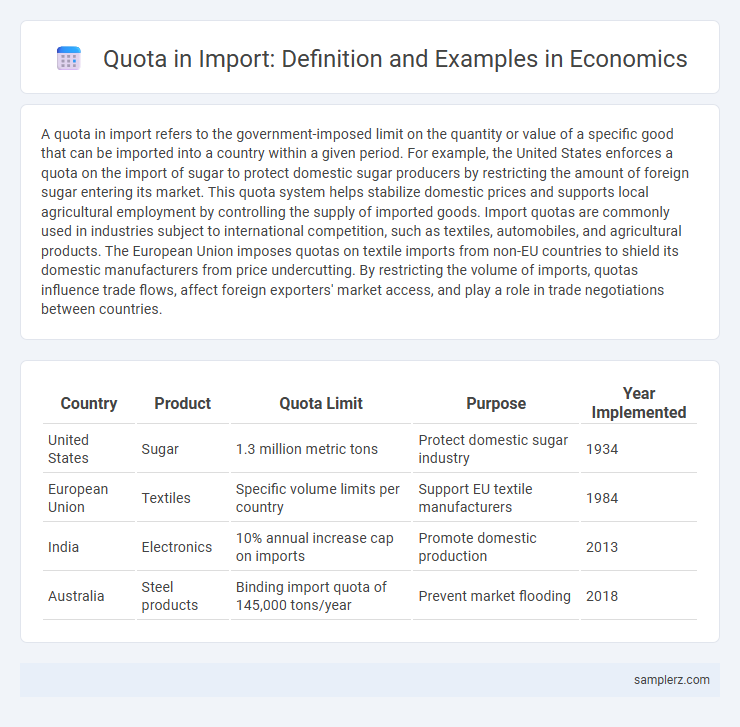A quota in import refers to the government-imposed limit on the quantity or value of a specific good that can be imported into a country within a given period. For example, the United States enforces a quota on the import of sugar to protect domestic sugar producers by restricting the amount of foreign sugar entering its market. This quota system helps stabilize domestic prices and supports local agricultural employment by controlling the supply of imported goods. Import quotas are commonly used in industries subject to international competition, such as textiles, automobiles, and agricultural products. The European Union imposes quotas on textile imports from non-EU countries to shield its domestic manufacturers from price undercutting. By restricting the volume of imports, quotas influence trade flows, affect foreign exporters' market access, and play a role in trade negotiations between countries.
Table of Comparison
| Country | Product | Quota Limit | Purpose | Year Implemented |
|---|---|---|---|---|
| United States | Sugar | 1.3 million metric tons | Protect domestic sugar industry | 1934 |
| European Union | Textiles | Specific volume limits per country | Support EU textile manufacturers | 1984 |
| India | Electronics | 10% annual increase cap on imports | Promote domestic production | 2013 |
| Australia | Steel products | Binding import quota of 145,000 tons/year | Prevent market flooding | 2018 |
Understanding Quotas: Definition and Purpose in Import Policies
Quotas in import policies limit the quantity of specific goods that can enter a country, helping protect domestic industries from foreign competition. By restricting imports, governments aim to balance trade deficits and stabilize local markets. These measures also influence international trade dynamics and pricing strategies.
Historical Examples of Import Quotas in Global Trade
Historical examples of import quotas reveal their strategic role in global trade, such as the United States' textile quotas under the Multi-Fiber Arrangement (MFA) from 1974 to 2005, which limited textile and apparel imports to protect domestic manufacturers. Another notable instance includes the European Economic Community's quotas on Japanese car imports in the 1980s, aimed at balancing trade and safeguarding European automotive industries. These examples illustrate how import quotas have been used to manage trade deficits, protect local jobs, and influence international trade dynamics.
Case Study: U.S. Import Quotas on Sugar
The U.S. import quotas on sugar restrict the quantity of foreign sugar that can enter the domestic market, stabilizing prices and protecting domestic sugar producers. These quotas have led to higher sugar prices in the U.S., benefiting domestic farmers but increasing costs for food manufacturers and consumers. The quota system exemplifies trade policy tools used to balance free trade benefits with protecting domestic industries.
Quota Implementation: European Union’s Textile Import Limits
The European Union enforces import quotas on textiles to protect its domestic industry and regulate trade balance, limiting the quantity of specific textile products imported annually. These quotas apply primarily to categories such as cotton and synthetic fibers, aiming to prevent market saturation and support European textile manufacturers. By restricting import volumes, the EU maintains stable prices and promotes sustainable competition within the internal market.
Impact of Import Quotas on Domestic Industries
Import quotas restrict the quantity of foreign goods, creating limited competition for domestic industries. This protection allows local manufacturers to increase production, preserve jobs, and potentially raise prices due to reduced market supply. However, consumers might face higher costs and less variety as a result of these limitations.
Quotas vs. Tariffs: Key Differences in Trade Regulation
Import quotas limit the quantity of goods, such as steel or textiles, entering a country, directly restricting supply and protecting domestic industries. Tariffs impose taxes on imported goods, increasing their prices and indirectly reducing demand while generating government revenue. Unlike tariffs, quotas create absolute trade limits without generating income, often leading to supply shortages and higher prices.
Import Quotas in Developing Countries: Examples and Outcomes
Import quotas in developing countries, such as India's restrictions on textile imports, aim to protect domestic industries by limiting foreign competition. These quotas often result in increased local production and job creation but can also lead to higher consumer prices and reduced product variety. For instance, Kenya's quota on sugar imports supports local farmers but occasionally triggers trade tensions with exporting countries.
Effects of Quotas on International Prices and Supply Chains
Quotas on imports restrict the quantity of goods entering a country, leading to reduced supply and increased prices in international markets. This limitation disrupts global supply chains by forcing manufacturers to seek alternative sources or adjust production schedules. The resultant scarcity elevates costs for consumers and creates volatility in trade relationships, impacting economic stability.
Legal Framework Governing Import Quotas in the WTO
The World Trade Organization (WTO) establishes a legal framework governing import quotas through agreements such as the General Agreement on Tariffs and Trade (GATT), specifically Article XI, which generally prohibits quantitative restrictions. Exceptions under specific Articles allow temporary import quotas for balance of payments reasons or to safeguard certain domestic industries. Members must notify the WTO of any quota measures and ensure these comply with transparency, fairness, and non-discrimination principles to maintain an open global trading system.
Future Trends: The Role of Import Quotas in Modern Economy
Import quotas are expected to evolve as key tools for governments to balance trade deficits and protect emerging industries in the face of global supply chain disruptions. Future trends indicate an increased reliance on digital monitoring and data analytics to enforce quotas more efficiently while minimizing market distortions. Economies adopting flexible quota systems may achieve improved trade negotiation leverage and foster sustainable domestic growth.

example of quota in import Infographic
 samplerz.com
samplerz.com